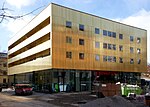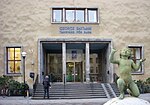St. Matthew's Church, Stockholm

St. Matthew's Church (Swedish: S:t Matteus kyrka) is a protected church located in the Vasastaden district of Stockholm, Sweden. Originally intended to be used as a chapel in the Adolf Fredrik Parish, it was designed by Erik Lallerstedt and built in 1901–1903, at an intersection in Vasastaden.The large hall at ground floor was first meant to be used for various charitable activities, as the chapel was located in a poor working-class neighbourhood at the time. The building is reminiscent in many ways of St Peter's Church in Norrmalm, a Methodist church also designed by Lallerstedt in 1899. Some changes were made in 1907–1908, under guidance of the original architect, when the parish was split and the chapel was turned into a parish church.
Excerpt from the Wikipedia article St. Matthew's Church, Stockholm (License: CC BY-SA 3.0, Authors, Images).St. Matthew's Church, Stockholm
Dalagatan, Stockholm Vasastaden (Norrmalms stadsdelsområde)
Geographical coordinates (GPS) Address External links Nearby Places Show on map
Geographical coordinates (GPS)
| Latitude | Longitude |
|---|---|
| N 59.345277777778 ° | E 18.0425 ° |
Address
Sankt Matteus kyrka
Dalagatan
113 22 Stockholm, Vasastaden (Norrmalms stadsdelsområde)
Sweden
Open on Google Maps









